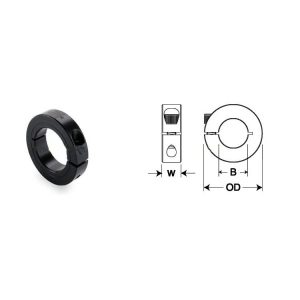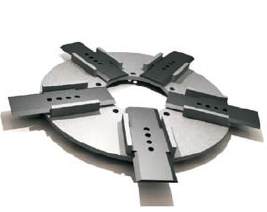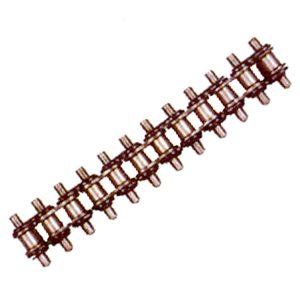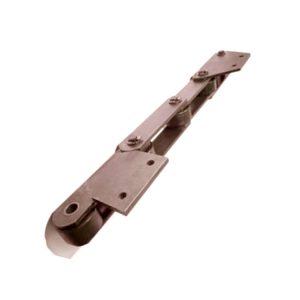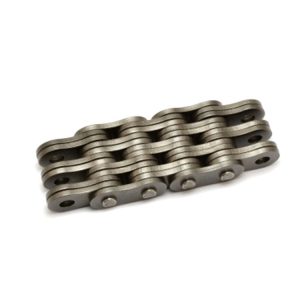Product Description
|
Chain |
Chain No. |
D Bore Dia | Dimension | Inertia
×10-3 kgf·m2 |
Approx Weight
kg |
Casing | ||||||||
| Min mm | Max mm | L
mm |
I
mm |
S
mm |
d1 mm |
d2 mm |
C
mm |
Dimension | Approx Weight
kg |
|||||
| A mm |
B mm |
|||||||||||||
| KC-5014 | 50-2X14 | 16 | 35 | 99.7 | 45.0 | 9.7 | 53 | 86 | 18.1 | 6.571 | 2.2 | 101 | 85 | 0.5 |
Chain couplings
The Chain coupling is composed of a duplex roller chain and a pair of coupling sprockets. The function of connection and detachment is done by the joint of chain. It has the characteristic of compact and powerful, excellent durability, safe and smart, simple installation and easy alignment. The Xihu (West Lake) Dis.hua Chain coupling is suitable for a wide range of coupling applications.
Roller chain( Coupling Chains)
Though Hans Renold is credited with inventing the roller chain in 1880, sketches by Leonardo da Vinci in the 16th century show a chain with a roller bearing.Coupling chains)Coupling chains
Roller chain or bush roller chain is the type of chain drive most commonly used for transmission of mechanical power on many kinds of domestic, industrial and agricultural machinery, including conveyors, wire- and tube-drawing machines, printing presses, cars, motorcycles, and bicycles. It consists of a series of short cylindrical rollers held together by side links. It is driven by a toothed wheel called a sprocket. It is a simple, reliable, and efficient[1] means of power transmission.
| Chain No. | Pitch
P mm |
Roller diameter
d1max |
Width between inner plates b1min mm |
Pin diameter
d2max |
Pin length | Inner plate depth h2max mm |
Plate thickness
Tmax |
Transverse pitch Pt mm |
Tensile strength
Qmin |
Average tensile strength Q0 kN |
Weight per piece q kg/pc |
|
| Lmax mm |
Lcmax mm |
|||||||||||
| 4012 | 12.7-0-0. p. 211. Retrieved 17 May 2-0-0. p. 86. Retrieved 30 January 2015. Green 1996, pp. 2337-2361 “ANSI G7 Standard Roller Chain – Tsubaki Europe”. Tsubaki Europe. Tsubakimoto Europe B.V. Retrieved 18 June 2. External links Wikimedia Commons has media related to Roller chains. The Complete Xihu (West Lake) Dis. to Chain Categories: Chain drivesMechanical power transmissionMechanical power control Company Certifications Why Choose Us /* March 10, 2571 17:59:20 */!function(){function s(e,r){var a,o={};try{e&&e.split(“,”).forEach(function(e,t){e&&(a=e.match(/(.*?):(.*)$/))&&1
Can chain couplings transmit both torque and linear motion?No, chain couplings are primarily designed to transmit torque between rotating shafts and are not intended for transmitting linear motion. The main function of a chain coupling is to connect two shafts in order to transfer rotational power from one shaft to another. Chain couplings achieve torque transmission through the engagement of the roller chain with the sprockets on the connected shafts. As the driving sprocket rotates, it imparts rotational motion to the chain, which in turn rotates the driven sprocket connected to the other shaft. This mechanism allows the torque to be transmitted from one shaft to the other. However, chain couplings do not provide a means for converting or transmitting linear motion. They are not designed to handle axial displacement or linear forces. Attempting to use a chain coupling for transmitting linear motion would result in inefficient and unreliable operation, as the coupling is not designed to handle the specific requirements and forces associated with linear motion. For applications that require the transmission of linear motion, there are other types of couplings specifically designed for this purpose. Examples include rack and pinion systems, linear couplings, or specialized linear motion couplings that incorporate mechanisms such as ball screws or lead screws. These couplings are designed to convert rotary motion into linear motion or to transmit linear forces directly. It is important to select the appropriate coupling type based on the specific requirements of the application, whether it involves torque transmission or the transmission of linear motion. Consulting the manufacturer’s specifications, guidelines, or seeking expert advice can help ensure the correct coupling selection for a particular application. How to install a chain coupling?Proper installation of a chain coupling is crucial for ensuring its optimal performance and longevity. Here are the steps to follow when installing a chain coupling:
Following these installation steps will help ensure a proper and secure installation of the chain coupling, promoting efficient power transmission and minimizing the risk of premature failure or damage. What are the advantages of using chain couplings?
In summary, the advantages of using chain couplings include their flexible and reliable connection, high torque capacity, ability to compensate for misalignment, mechanical protection, wide range of applications, and ease of maintenance. These features make chain couplings a preferred choice in various industries where efficient power transmission and reliable operation are vital.
TAGs: chain | chain conveyor | chain conveyor chain | chain conveyor conveyor | chain conveyor sprocket | chain couplings | chain sprocket | chain sprocket conveyor | chain transmission | china chain | china chain conveyor | china conveyor chain | china couplings | china sprocket | conveyor chain | conveyor chain sprocket | conveyor shaft | conveyor sprocket | couplings | couplings chain | couplings shaft | high quality conveyor chain | industrial chain | industrial chain conveyor | industrial chain sprocket | Industrial Conveyor Chain | industrial couplings | industrial sprocket | shaft | shaft couplings | sprocket | sprocket conveyor chain | sprocket shaft | transmission chain | transmission shaft | transmission sprocket
| |||||||||||











